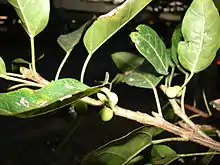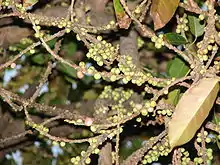Ficus nota
Ficus nota is a species of flowering plant in the family Moraceae.[2] It is commonly known as tibig or sacking tree, is a species of fig tree found near water in low altitudes. Tibig is native to the Philippines. They are also found in parts of northern Borneo in Malaysia.The tree can grow up to 9 meters high. It is primarily dispersed by birds which eat the fruits and excrete the seeds. The fruits are also edible to humans, although they are rather bland. They are usually eaten with sugar and cream in the Philippines. The young leaves are also eaten as a vegetable.[3][4][5]
| Ficus nota | |
|---|---|
 | |
 | |
| Ficus nota in Hawaii | |
| Scientific classification | |
| Kingdom: | Plantae |
| Clade: | Tracheophytes |
| Clade: | Angiosperms |
| Clade: | Eudicots |
| Clade: | Rosids |
| Order: | Rosales |
| Family: | Moraceae |
| Genus: | Ficus |
| Subgenus: | F. subg. Sycomorus |
| Species: | F. nota |
| Binomial name | |
| Ficus nota | |
References
- IUCN SSC Global Tree Specialist Group & Botanic Gardens Conservation International (BGCI) (2019). "Ficus nota". IUCN Red List of Threatened Species. 2019: e.T156206170A156216213. doi:10.2305/IUCN.UK.2019-3.RLTS.T156206170A156216213.en. Retrieved August 23, 2020.
- "Ficus nota (Blanco) Merr". Plants of the World Online. The Trustees of the Royal Botanic Gardens, Kew. n.d. Retrieved August 23, 2020.
- "Ficus nota". Pacific Island Ecosystems at Risk. Hawaiian Ecosystems at Risk project. January 1, 1999. Retrieved 2009-05-05.
- Fern, Ken. "Ficus nota". Tropical Plants Database. Retrieved 18 May 2019.
- "Tibig". Expanded National Greening Program. Department of Environment and Natural Resources, Republic of the Philippines. Retrieved 18 May 2019.
| Wikimedia Commons has media related to Ficus nota. |
This article is issued from Wikipedia. The text is licensed under Creative Commons - Attribution - Sharealike. Additional terms may apply for the media files.
